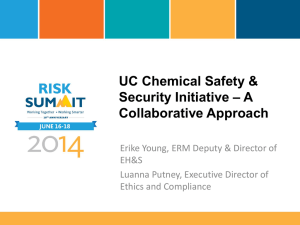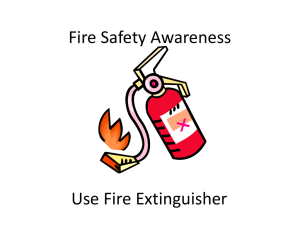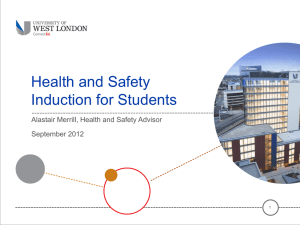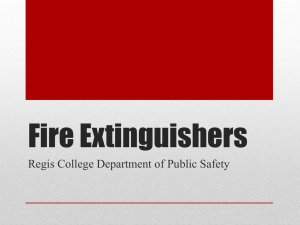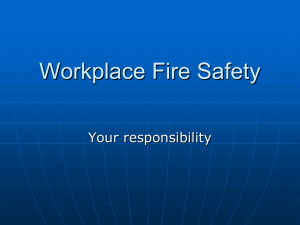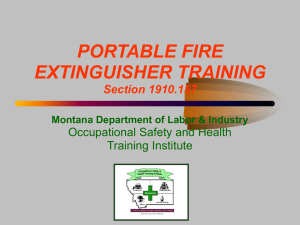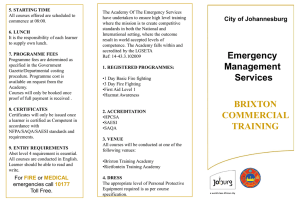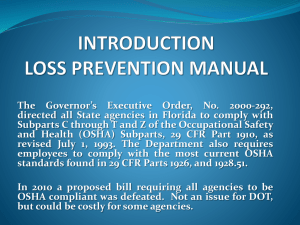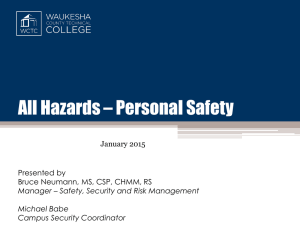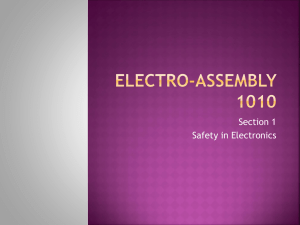PowerPoint
advertisement
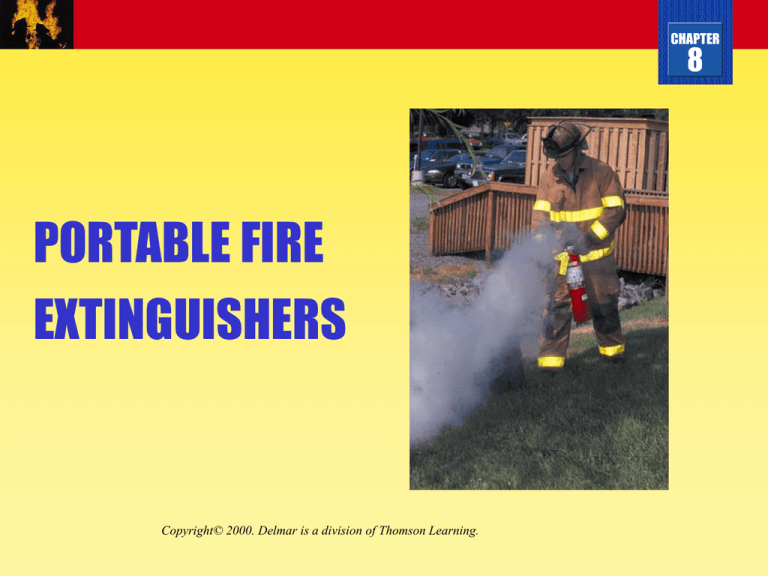
CHAPTER 8 PORTABLE FIRE EXTINGUISHERS Copyright© 2000. Delmar is a division of Thomson Learning. CHAPTER 8 Objectives 1 of 2 • Explain the five classes of fire and the risks associated with each class. • Identify the kinds of fire extinguishers used for each class. • Explain the rating systems of portable extinguishers for Classes A,B, and C. • Identify the limitations of portable extinguishers. CHAPTER 8 Objectives 2 of 2 • Demonstrate the operation of portable fire extinguishers. • Explain the care and maintenance of portable fire extinguishers. • Discuss the inspection requirements of portable fire extinguishers. CHAPTER 8 Introduction 1 of 2 • Portable fire extinguishers are designed to fight small incipient fires. • Firefighters must know how to use extinguishers and be able to teach others. • Proper instruction can improve department effectiveness and reduce damage costs. • Fire extinguishers come in a variety of types and sizes. CHAPTER 8 Introduction 2 of 2 • Firefighters should know the extinguishers carried on apparatus. • Citizens will often request information and training on the use of extinguishers. • Firefighters should be capable of answering questions regarding fire extinguishers. CHAPTER 8 Fire Classification and Risk • The type and nature of the burning material (fuel) defines the fire. • Currently 5 classes of fire • Class A • Class B • Class C • Class D • Class K* *As of 1998 CHAPTER 8 Class K Equipment CHAPTER 8 Types of Fire Extinguishers • Many types of fire extinguishers are available today. CHAPTER 8 Types of Fire Extinguishers • Many factors need to be considered before using an extinguisher: • Type and amount of fuel. • User and occupancy. • Building construction. • Environmental conditions. • Type of equipment being protected. CHAPTER 8 Types of Extinguishing Agents 1 of 2 • Water is the basic agent for Class A fires. • Water-based foam extinguishers for class B fires have either AFFF or FFFP. • CO2 is an inert gas stored under pressure. • CO2 is effective on Class B or C fires. • Dry chemical agents are particles propelled by a gaseous medium. • There are three categories of dry chemicals. CHAPTER 8 Types of Extinguishing Agents • • • • 2 of 2 Wet chemicals are water-based solutions. Wet-chemicals are used for Class K fires. Clean agents have replaced Halons. Clean agents do not conduct electricity or leave a residue. • There are two classes: Halocarbon agents and inerting gases. CHAPTER 8 Kinds of Extinguishers • Pump-type extinguishers are hand pumped devices. • Pressurized extinguishers operate by expelling gas that propels the agent out. • Cartridge-operated extinguishers used for dry chemical and most dry powder Class D extinguishers. CHAPTER 8 Backpack Pump Tank CHAPTER 8 Stored Pressure Water Extinguisher Stored Pressure Foam Extinguisher CHAPTER 8 Stored Pressure Dry Chemical Extinguisher Carbon Dioxide Extinguishers CHAPTER 8 Cartridge-Operated Dry Chemical Extinguisher CHAPTER Rating Systems of Portable Extinguishers 8 • Each class of fuel is subject to a separate type of rating test. • Class A rating test uses wooden cribbing test. • Class B rating test uses a pan of flammable liquid. • Class C rating test only involves conductivity of the agent and the nozzle or hose and nozzle combination.. CHAPTER 8 Limitations of Portable Extinguishers • Extinguishers have limited capabilities. • They are designed and rated for certain types and sizes of fire. • Wrong extinguisher will create greater problems. • Need to use right extinguisher for the fire present. CHAPTER 8 Extinguisher Operation • P ull the pin. • A im the nozzle. • S queeze the handle. • S weep the nozzle. CHAPTER Care and Maintenance of Portable Extinguishers • Carefully inspect before placing in service. • Should be periodically removed from bracket. • Dry chemical extinguishers should be inverted occasionally. • Clean dirt and grit to maintain good working order. 8 CHAPTER 8 Obsolete Extinguishers • • • • • • Soda acid. Chemical foam (except film-forming.) Vaporizing liquids. Cartridge-operated water or loaded stream. Copper or brass extinguishers. Firefighters should never operate obsolete extinguishers. CHAPTER 8 Inspection Requirements • • • • 1 of 2 Should be checked every 30 days. First perform visual inspection. Pin seal should be in place. Gauge should register proper pressure. CHAPTER 8 Inspection Requirements 2 of 2 • Some extinguishers, such as CO2, only checked by weighing. • Weight is stamped on cylinder. • Check for hydrostatic testing. CHAPTER 8 WRAP-UP • There are various classes of fires. • There are various kinds of extinguishers. • Proper type of extinguisher needed for various classes of fire. • Important to remember extinguishers have limitations. • Extinguishers need to be maintained, serviced, and inspected regularly.
